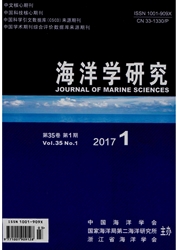

 中文摘要:
中文摘要:
对收集、整理的462组大地热流和地温梯度数据进行统计分析,结果表明南海北部陆缘具有普遍偏高的大地热流和地温梯度,大地热流总体表现为由陆架向洋盆方向递增的趋势。海底热流资料经稳态温度场计算南海北部随深度变化的热流和温度分布,获取热居里面深度,与地磁资料反演的居里面深度进行对比,发现南海北部中、下陆坡磁居里面深度浅于热居里面深度,处于地热不平衡状态。通过对地壳结构、拉张因子、莫霍面埋深、断裂带及火山活动的综合分析,表明南海北部陆缘地热状态受控于地壳拉张减薄和莫霍面抬升的构造格局,裂后晚期局部岩浆活动对地热状态亦有影响。
 英文摘要:
英文摘要:
With the statistic results about a total number of 462 heat flow values and geothermal gradient values,the present geothermal field in the northern margin of the South China Sea is characterized with"general higher heat flow values and higher geothermal gradient values".The heat flow values increase from continental shelf to ocean basin against the trend of the crust thickness and Moho depth.Thermal Curie Point Isotherm(the 575 ℃isotherm)was obtained according to the static geothermal temperature field calculated from the heat flow and geothermal gradient survey data.Magnetic Curie Point Isotherm was obtained by inversion of the magnetic anomalies.The results show that the two Curie Point Isotherms derived respectively from the prior two methods are inconsistent with significant differences in the middle and lower slope in the northern margin of the South China Sea.The Magnetic Curie Point Isotherm is above the Thermal Curie Point Isotherm between fault F2 and fault F4 in the integrated profiles of OBS93 and ESP-E,which means that some magma under-plating events caused the thermal disequilibrium in this region.Based on the study of the crust structure,crust expansion coefficient,Moho depth,faults and magma activities,the author points out that the variation trend of the heat flow values in the northern margin of the South China Sea is controlled by the magnitude of the lithosphere thinning and Moho uplifting.The magma activities during the Neo-tectonic period might be a factor for the local heat flow anomaly.
 同期刊论文项目
同期刊论文项目
 同项目期刊论文
同项目期刊论文
 期刊信息
期刊信息
